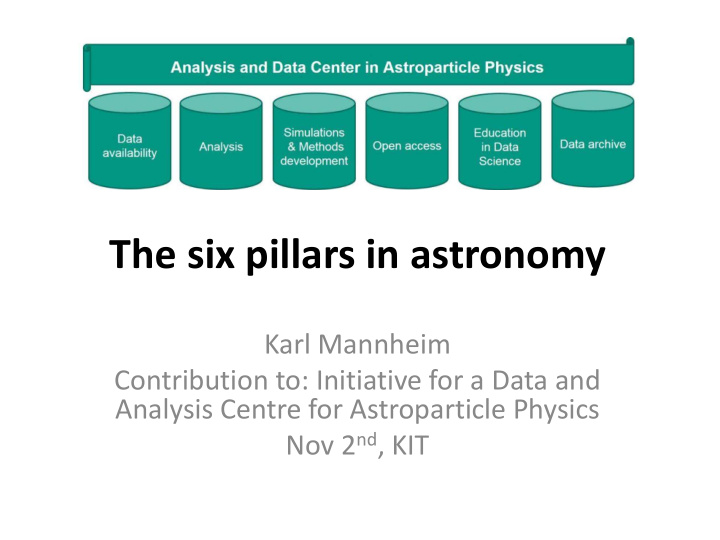



The six pillars in astronomy Karl Mannheim Contribution to: Initiative for a Data and Analysis Centre for Astroparticle Physics Nov 2 nd , KIT
General ROOTS: Define data products transmitted via gateway from central • computing facilities of hosted telescopes • FLEXIBILITY : diversity of data pipelines • MANPOWER: developing and maintaining data pipelines • COMPUTING: processing of raw data to generate high-level data • ARCHIVE: Long-term cost-efficient raw data storage • DISSEMINATION: Storage and secure external access to high-level data • HPC: Monte Carlo/numerical simulations (interface to specialized HPCs?) • R&D : evolutionary approach to optimize modus operandi • SUSTAINABILITY • TRAINING VIRTUAL OBSERVATORY: ( external partners such as CDS or GAVO) • – Overlay images and c ross-identifications – Multi-wavelength spectra (correlations in energy space) – Statistical analysis (spatial correlations) – Time-domain studies (temporal correlations, transients) – Source classification (machine learning) – Pretty pictures and movies (public outreach)
Examples • Examples of data/HPC center support: – Jülich Supercomputing Centre : LOFAR/SKA data-pipeline support – Rechenzentrum Garching : EUCLID collects >500,000 images during 6 years of operation (30 Pbytes). Combine with hybrid data from ground-based spectroscopy (e.g. DES, KIDS). RZG provides: 36 compute nodes with 576 kernels and 500 TB storage realized as GPFS, external data access using gridFTP or Globus Online and external access to computing by globus GRAM. – LRZ: SuperMUC (2 Pflops/s) for numerical simulations (MHD, PIC) Education : Hands-on-Universe, robotic telescopes (MONET), citizen • science (SETI, Panstarrs, galaxy zoo of SDSS) • Upcoming : Euclid, eROSITA, Athena, LSST, ELT, CTA, LOFAR, SKA Denkschrift 2017 & Strategiepapiere (RDS) • – Information Science and E-Infrastructure Challenges in Astronomy (Polsterer et al.) – Computational Astrophysics (Röpke et al.) www.denkschrift2017.de
SKA: HQ in UK; telescopes in AUS & RSA SKA1-LOW: 50 – 350 MHz Phase 1: ~130,000 antennas across 65km SKA1-Mid: 350 MHz – 24 GHz Phase 1: 200 15-m dishes across 150 km
Data Flow through the SKA SKA1-MID ~50 PFLOPS 8.8 Tb/s 7.2 Tb/s ~5 Tb/s ~2 Pb/s ~250 PFLOPS beamforming SKA1-LOW ~300 PB / year Footer text
Raw data processing is extremely challenging - Pre-analysis in near-realtime and strong data reduction (~ 10 5 ) - Science data products = large objects (up to ~ 1 Petabyte / 3D image) - To be “improved” in Regional Data Centers
SKA Regional Centres – outside SKAO scope Required • • capacity for reprocessing data and their analysis • storage for a long-term archive • local user support South Africa • Intent • SKA partner countries planning SKA regional Centres AUS National super-computing • centres Australia Provide local support to • scientists RSA • Development of new techniques, new algorithms • Deliver SKA science
SKA Regional Centre merging individual observations of long term projects
SKA Regional Centre
SKA Regional Centre Discovery of the un-knowns in semi-raw visibility data Data Cubes: 36.600 x 36.600 x 250.000 Pixel up to PetaByte / Cube
SKA - telescope Opportunity for new developments SKA Regional that can feedback into the science Centre data processing scheme
National SKA Data Centre Magnetic Pulsars Surveys Cosmic Rays Transients Fields Lab 1 Lab 2 Lab 3 Lab 5 Lab 4 Integration Lab 5 Key Science Labs The SKAO has compiled a list of 13 High Priority Science Objectives (HPSO) • • HPSO require different approaches in data analytics due to different nature of data. 1 Integration Lab (general support) Basic services: Network, HPC, system integration • • Theory: Information theory, algorithms for Big Data analytics, Machine Learning, … In total: approx. 50 people required • How to set this up properly ?
Think big enough! • SKA national center could host all other experiments/observatories Amazon-type of investment: civil playground for future big data • analytics developers • Part of European science cloud based on CERN-SKA cooperation: Each of the current HGF centers is way too small! Data archive • – Ten-ExaByte -scale mass storage with fast access – Responsibility for part of SKA central computing facility – Sustainable design (power supply /waste heat for green houses) • Analysis and data science competence center – Ten-PFLOPS-scale compute power – 50 data scientists – Software implementations of data pipelines – Algorithms for data analysis and visualisation – User support • Master-supplement „ data scientist/engineer “
Recommend
More recommend